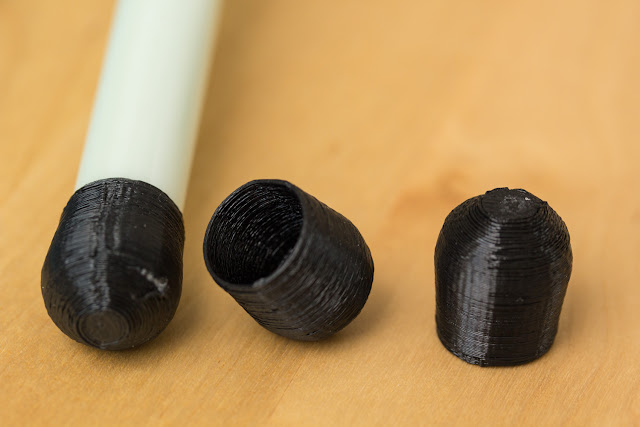With proper X axis tension, the printer is happily printing. I left it run for hours while we were away for the Street Food Festival, and it was still running merrily when we came back.
This particular print was designed this morning to match our balcony bench's feet, so it can stand up more straight on the slanted balcony. I didn't incorporate the angle of the bench's feed, so it might not work well in the long run, but it works for now, and I don't want to do another print of that length without good reason.
I suspect the reason for the Z offset changes has less to do with the frame expanding and more with just the holders getting push a tiny bit up every print, more if the print warps. The offset is always increasing and then gets reset when I fiddle with it. If it was the temperature/humidity/pressure, it would be going more up and down. So I should try gently bonking down the two Z axis mounts to check if that keeps the calibration.
After my failure with the
AA battery dispenser extension, I filed a bug against Slic3r - originally for failing to slice right, but it turned out the model was just broken. I changed the bug to suggest doing a better error message - "auto-repaired" sounds like it actually works, "attempted repaired" would be better. The discussion around this pointed me at
netfabb.com/service, which offers repairing STLs for free. With that, the dispenser actually printed right:
I printed a little mount thing for putting up my name sign at work. Unfortunately, I'm not exactly sure where the name sign is.
I started printing a
solder fume extractor, but it ate a lot more filament than I expected, I had to stop halfway through when my white filament ran out. Now I have a useless white thing.
This was also the largest rectangular thing I printed so far, at 13x13 cm, so I was extra careful to keep an eye on the clips on the side. The duct fan mount is just high enough that it doesn't hit the clips here. Oddly, the print wasn't really on the center of the bed, but towards the back:
I had a sample of PETG lying around from an earlier order from
dasfilament.de. Since my white ran out. I figured it'd be a good time to try that. I did a
Bugz because it's small and I had problems with it sticking together in PLA.
When that came out well (and was able to move), I did a McBenchy, of course, which came with a much better bow and almost-readable letters, but dangling filament atop the windows:
 |
| Nice overall, but some sagging at the window |
 |
| Look at that nice, smooth bow |
 |
| Still some gaps in the foredeck |
 |
| Stringing in several places - I suspect more retraction would be needed. |
 |
| The name can almost be read. But what's with the hole in the bottom left? |
 |
| On a second partial print with higher start position, you can almost read the undertext. |
Unfortunately, the Rubinrot (RAL 3003) offered is not
quite the shade of red we want in the kitchen, we want Kirschrot. And the filament that they call Kirschrot is misdescribed as Rubinrot, so not I don't really know what it is.
One problem with PETG is that it doesn't print into thin air as easily. Not only does it sag in horizontal prints, unless PLA which can actually print straight across nothing, but it also requires support at a much higher overhang angle. An attempt involving a halfcircle fell down despite support material at an overhang of 40 degrees.
I'm starting up my balcony garden, now that it's nice weather again, and I want to use the two semi-spherical plant boxes I have, However, they don't come with a good holder, nor a good hole to stick a holder through. So rather than drilling a little hole, I of course design a matching holder:
I believe the PETG would be the appropriate material for this, having better structural integrity as well as probably being able to withstand the weather better. I should probably print it sideways to not put the stress on the layers, but across them, and to avoid the overhang problem above.
An advantage of using Octoprint is that I can go back and see what I have printed, hence the many things listed this time.

























